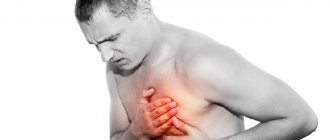A lump in the throat causes a pressing feeling of lack of air and interferes with the swallowing reflex. A person experiences heartburn, sore throat, and cough. Sometimes this symptom is associated with pain in the back of the head and numbness in the arms and legs. The symptoms are caused by the penetration of an excessive amount of air into the body; the stomach accumulates excess gases inside itself, which leads to increased pressure inside it. To get rid of the resulting load, the muscle begins to contract, the sphincter relaxes, resulting in unpleasant symptoms of belching air and the sensation of a foreign body in the oropharynx and esophagus.
The patient often complains of difficulty swallowing, tries to swallow a lump in the throat, but as a result, the obstruction remains in place and air escapes from the mouth. Constantly haunted by the feeling of finding a foreign body. A person often does not feel pain; there is a feeling of neck compression, sometimes partial suffocation. Accompanied by a burning sensation in the oropharynx. If you notice any of the following symptoms, be sure to consult a doctor:
- Feeling of constant pressure in the neck area.
- Feeling of a moving lump at the beginning of the esophagus.
- Difficulty swallowing saliva.
- A tickling sensation, as if the mucous membrane had been scratched.
- It seems that swallowing does not go completely and comes back unfinished.
- The desire to constantly swallow when there is no such need.
- It is difficult to swallow food of different densities alternating between liquid, solid, then liquid again.
There is a widespread belief that the occurrence of belching and the feeling of a coma are completely natural phenomena, caused by human physiology. But often the sensations cause a lot of inconvenience, put a person in an awkward position, make it difficult to eat, and cause a sharp cough. If the symptoms are chronic and are observed constantly, you need to urgently consult a doctor to avoid complications, since what is happening is a sign of other serious diseases.
Etiology
It is important to identify the type of underlying irritant before taking corrective action. A lump in the esophagus may indicate the presence of the following problems:
- Diseases of some internal organ, namely the esophagus, heart, lungs, muscles.
- Pathologies of any nature. Compression of the larynx is explained by the concentration of complex nerve and vascular accumulations in the sternum.
- Diseases of the organs inside the abdomen due to their proximity to the pectoral muscles.
Pathological conditions that provoke the appearance of unpleasant symptoms:
- inflammation of the serous membrane;
- changes in the heart walls;
- rupture of a cyst in the lung;
- inflammation of the cartilage in the ribs;
- rib fractures with compression of the intercostal space.
Cardiac dysfunction also results in pain and discomfort in the throat and chest. At the very beginning, unpleasant sensations that something is interfering occur with angina pectoris, often due to atherosclerosis. As the disease progresses, a symptom of congestion appears behind the sternum, a constant desire to swallow a lump due to compression of the esophagus by the dilated heart muscle. Myocardial infarction provokes similar symptoms that persist for a long time.
Possible causes and symptoms of pain in the esophagus
Numerous additional tests are helpful in diagnosing esophageal pain. Three main research methods are used as a standard:
- X-ray of the esophagus after administration of a contrast agent.
- Endoscopic examination.
- Esophagomanometry of the esophagus.
An X-ray contrast agent allows one to visualize narrowing or stretching of the esophagus, the presence of a tumor in the esophagus or diverticulum, or simply scan the esophageal passage. During an endoscopic examination, changes located inside the wall of the esophagus can be detected, and above all, a developing tumor can be identified.
How is esophageal manometry done?
During endoscopy, biomaterial is collected from the walls of the mucous membrane for histopathological examination. In turn, esophageal manometry measures the muscle tone of the organ of the digestive system. This is useful in the diagnosis of achalasia and spasticity of the esophagus. When diagnosing gastroesophageal reflux disease (GERD), a 24-hour pH measurement and the so-called esophageal impedance are prescribed, which provides information about the volume and type of contents, gas or liquid in the cavity environment. In addition, if suspected for cancer, and assessment of severity, ultrasound, CT and MRI of the esophagus are prescribed.
When the esophagus hurts during swallowing, you need to seek help from a gastroenterologist, since it is this doctor who treats diseases of the esophagus and gastrointestinal tract.
In severe forms of the disease, consultation with a surgeon is often required.
Dysphagia - a violation of swallowing movements can appear due to muscle spasm, anatomical features, after a stroke, age-related atrophy and other conditions. At the same time, the unpleasant feeling that food is in the esophagus is quite justified. The pathology is accompanied by:
- feeling of fullness behind the sternum;
- difficulty passing dense foods;
- increased act of swallowing;
- lack of air when eating.
Cough from the stomach and esophagus that accompanies dysphagia is caused by the accumulation of food masses. In this case, the pathology does not cause pain.
Causes
The causative factors that cause the feeling that there is a lump in the esophagus are diverse and are represented by the following list:
- Swelling of the larynx due to inflammation of the mucous membrane. The process is accompanied by tickling and tickling.
- Pharyngitis, during which there is also pain in the back of the head.
- Abscess in the retropharyngeal region.
- The development of tumors that affect the throat, stomach, chest, neck. The first symptom is mucus coming out of the throat. In severe cases, blood clots appear and people feel that food is not passing through.
- Thyroid dysfunction due to inflammation or goiter (enlargement of the organ due to iodine deficiency).
- Excessive stress, hysterical and depressive states, causing spasm of the pharyngeal muscles, which provokes belching.
- Conversion disorder, accompanied by tingling and numbness in the hands, and constant ringing in the ears.
- Displacement of spinal discs or cartilage, neck injuries. Provoking factors in this case are incorrect posture, sedentary work, and congenital fragility of ligaments and bones.
- Diaphragmatic hiatal hernia with compression of the vagus nerve. It feels like there is a food stake, and it puts pressure on the walls of the sternum when overeating or maintaining an uncomfortable body position for a long time. The condition is characterized by severe belching.
- Gastritis, reflux disease and other digestive tract disorders. There is constant irritation of the esophageal mucosa, which provokes spasm. The mechanism of movement of food is disrupted and a blockage occurs in the throat, belching occurs.
- Excess body weight, formation of voluminous subcutaneous fat.
- Injuries to the esophagus and larynx during endoscopy, ingestion and movement of sharp objects or large pieces of food, thermal and chemical burns.
- Vegetative-vascular dystonia.
- Other pathologies: bronchial asthma, gastric ulcer, arterial hypertension, tuberculosis.
- Long-term use of antacids.
The feeling of a lump in the esophagus can have different causes. Discomfort may occur due to:
- swelling of the throat, soreness, tickling;
- pharyngitis, pain in the back of the head;
- abscess in the space behind the pharynx, tumor development.
Disorders, inflammation, enlargement (with goiter) of the thyroid gland. Goiter is considered an autoimmune disease, develops due to a lack of iodine in the body, a lump compresses the tissues of the throat. To stabilize the condition and replenish iodine, iodine-containing drugs and medications for goiter resorption are prescribed.
Frequent stress, negative emotions, and a hysterical state often lead to spasms of the throat muscles, a feeling of a coma, which goes away after a good massage and proper rest in the fresh air.
Tingling, numbness in the hands, and constant ringing in the ears can lead to a feeling of a lump in the throat, the so-called conversion disorder manifests itself. The help of a psychotherapist in this case is simply necessary.
Nervous system disorders cause a feeling of a lump in the throat. If you have this symptom, you need to see a doctor and undergo an examination; perhaps this is a symptom of a serious illness, development, proliferation of tumor cells.
Displacement of spinal tissues and problems with the cervical spine can cause a foreign body in the throat. Tissue modification occurs as a result of a sedentary lifestyle and incorrect body position for a long period of time. Ligaments and bones become fragile, quickly shift, and a lump in the throat is also a sign of these diseases. Vacuum therapy, manual therapy, acupuncture are indicated for treatment, and back massage helps a lot.
A hiatal hernia causes compression of the vagus nerve. A lump in the throat may appear after overeating or staying in the same uncomfortable position for a long time.
Gastritis and reflex disease lead to irritation of the tissues in the throat as a result of gastric juice entering the esophagus. If you have these diseases, as well as if you are overweight, you need to consult a gastroenterologist, adjust your diet, and possibly go on a diet.
If you are overweight, subcutaneous fatty tissue can compress and prop up your throat. There is heaviness in the stomach, belching, when overeating, especially in the evening - difficulty breathing, feeling of a lump in the throat. It is not recommended for everyone to eat at night, especially for obese people; calories are not burned when a person is lying down, but become the cause of the development of many diseases, in addition to weight gain, leading to a feeling of heaviness and a lump in the throat.
Discharge from the throat in the form of mucus and blood can cause serious cancer; it becomes difficult for the patient to swallow; when swallowing, it feels like there is a lump in the throat. Consultation with an oncologist is necessary. In the absence of cancer, problems with the throat, stomach, injury to the neck, chest, and development of anamnesis are possible.
If sputum is coughed up with blood, pulmonary tuberculosis can be suspected. In this case, you need to do fluorography and visit a phthisiatrician.
Injury to the esophagus or larynx often leads to the sensation of a foreign body in the throat. The very vulnerable mucous membrane of the throat can be damaged by simply swallowing a probe under the guidance of negligent and insufficiently educated doctors. The mucous membrane can be damaged by swallowing sharp objects or unusual spicy foods.
Dystonia of the vegetative-vascular system leads to disturbances in the autonomic nervous system. A lump sticks to the throat with bronchial asthma, stomach ulcers, arterial hypertension, bronchial asthma.
Hyperventilation syndrome can cause a lump in the throat. You need to reconsider your diet, limit physical and emotional stress, and be examined by a therapist or neurologist.
With diseases of the intestines or gallbladder, there may be a lump in the throat; after eating fatty foods, the sensations may only intensify.
Long-term use of antacids leads to pain in the right side, a sore throat, as a result of disturbances in mucus secretion.
Air in the stomach due to illness
If there is constant belching and stomach pain, the reasons may be hidden in the presence of diseases of the digestive tract. The following symptoms occur:
- with gastritis;
- peptic ulcer of the stomach and intestines;
- hiatal hernia;
- reflux - esophagitis;
- Zenker's diverticulum;
- achalasia cardia;
- scleroderma of the esophagus;
- pyloric stenosis;
- liver and gallbladder diseases. This includes diseases such as cholecystitis, cirrhosis, pancreatitis;
- pathologies of the cardiovascular system.
In medicine there is even such a thing as neurotic aerophagia. This process is characterized by voluntary swallowing of air, regardless of the influence of other causes. Its symptoms begin to appear with irritation, stress and nervous tension.
Diagnostics
To determine the causes of the problem and make a diagnosis, laboratory research methods are prescribed.
A lump in the throat seems harmless at first glance, but sometimes it can signal a serious problem. To determine the diagnosis, causes, and choose treatment, the doctor prescribes the following procedures:
- general tests of blood, urine, feces;
- biochemical and hormonal research;
- Ultrasound;
- visual examination by an ENT doctor, neurologist, endocrinologist;
- X-ray, MRI or CT.
A lump in the throat is not always so harmless; in most cases, it is a serious symptom indicating serious problems with a person’s health.
To make the diagnosis more accurate, the doctor may prescribe:
- general blood and urine tests;
- taking a biochemistry test;
- Ultrasound of the thyroid gland;
- hormone analysis (if a tumor or throat abscess is suspected);
- visual examination of the oral cavity, vocal cords, larynx, neck lymph nodes;
- X-ray of the cervical spine.
It is mandatory to be examined by an ENT doctor and an endocrinologist. If the larynx is normal, without deviations, a feeling of coma may appear due to nervousness, you should consult a neurologist. Esophageal congestion may be due to oncological reasons. Even a small tumor can compress the walls of the throat, leading to a lump in the throat, heartburn, and difficulty swallowing. As the tumor grows, pressure begins to put on the heart; early stage cancer is possible; a full examination is necessary.
When the walls of the sternum are physically injured, soft tissues are compressed, the ribs are deformed, a lump props up against the throat, a bruise of the sternum is fraught with hemorrhage into the chest cavity, and respiratory arrest. If at the same time there is compression of the esophagus, then swallowing is difficult, the skin in the sternum area becomes bluish, an ambulance should be called immediately.
As first aid you need to apply to the sore spot:
- apply a bandage that will reduce the feeling of pain;
- apply a cold compress to reduce the bleeding area;
- give the patient an anesthetic in the form of spasgan, analgin, baralgin;
- provide the patient with complete rest and immobility.
Pathology of the pleura and lungs
With the sudden appearance of heaviness in the chest, one cannot help but think that there is a pulmonary-pleural disease. Most often we are talking about an inflammatory process - exudative pleurisy or pneumonia. In such a situation, attention is drawn to general and local symptoms:
- wet or dry cough;
- mixed type of shortness of breath;
- chest pain when breathing (on the left or right side);
- deep breathing is difficult;
- malaise;
- fever.
Unlike the listed conditions, the development of tuberculosis is gradual. For a long time, the disease manifests itself as low-grade fever, weakness, and loss of appetite. Cough does not always attract the attention of patients, especially in smokers. However, over time, it is accompanied by symptoms of respiratory failure, and coughing up blood appears.
Patients with pneumothorax deteriorate fairly quickly. Air entering the pleural cavity compresses the lung. It becomes difficult for a person to breathe, sharp pains arise that radiate to the sternum and neck. The neck veins swell, the heartbeat quickens, the skin turns pale, and a feeling of anxiety appears.
During examination, many conditions accompany the lag of the affected part of the chest in the process of breathing. Auscultation reveals decreased breathing, crepitus or moist rales, and pleural friction noise.
What else could a lump in the middle of the sternum mean?
Damage to the esophageal mucosa
The sensation of a lump is a characteristic symptom of damage to the esophagus.
The feeling as if there is a lump in the larynx can be caused by:
- acute or chronic esophagitis;
- cancerous tumors;
- reflux disease.
This is characterized by the development of additional symptoms, namely:
- burning, heaviness;
- nausea with vomiting;
- difficulty moving food;
- compression of the esophagus, lack of air;
- sharp pain;
- fever, malaise;
- belching, hiccups;
- increased salivation.
Reasons for this:
- damage to the esophageal mucosa by bacteria, viruses or toxins;
- injuries from chemicals, hot food or mechanical means;
- food allergies;
- constant irritation of the mucous membrane with digestive juice when it is thrown back from the stomach.
Treatment is carried out according to the identified pathology.
Air in the stomach after eating food
Gas formation in the gastrointestinal tract is a physiological process. If this process is accompanied only by belching, then there is no need to worry. The air comes out in the way that is most convenient for him. It all depends on where the oxygen bubbles accumulate.
Belching and stomach pain often occur when constantly snacking on the run. Also, specific foods, drinking plenty of sugary drinks and eating a large portion of lunch can also be a decisive factor.
If your stomach hurts and belching constantly, you need to pay attention to other accompanying symptoms.
With cholecystitis, a painful feeling will occur in the right side under the rib. At the same time, fatty foods are poorly absorbed by the body.
With gastritis and peptic ulcers, a discomfort will appear in the epigastric zone. In addition to all this, during an exacerbation of the disease, the patient will complain of nausea, constipation or diarrhea, and vomiting.
How to treat a lump in the throat
When they feel a lump in their throat, many try to solve the problem on their own, they begin to gargle vigorously, inject aerosols, and take lozenges.
In most cases, this is not only ineffective, but can aggravate the situation, complicate the situation, for example, with sore throat, pharyngitis, acute laryngitis, in which the symptom of coma is observed in every 2-3 cases.
You can help yourself, for example:
- Improve your sleep, ventilate the room before going to bed, try to get a good night's sleep. To sleep in a comfortable position, without injuring the entire spinal system and cervical vertebrae, it is recommended to sleep on a middle pillow, on a hard and flat bed.
- Regulate your diet; it should be of high quality, rational, and avoid overeating at night.
- Walk more in the fresh air.
Treating a lump in the throat with folk remedies is not a solution. Symptoms may stop temporarily, but then return with a vengeance. Only correct diagnosis of this symptom and treatment at an early stage will protect you from many serious, sometimes insidious diseases (tumors, cancer, ulcers), one of the symptoms of which is such a harmless lump in the throat, which is sometimes not taken seriously by people.
How to get rid of it?
Drugs
If the air from the stomach does not pass well due to the development of gastroenterological diseases, the following groups of drugs can help combat the problem:
- Antibacterial agents. Prescribed to patients diagnosed with gastritis or stomach ulcers. The following medications will help destroy the Helicobacter pylori bacterium: “Enterofuril”;
- "Enterol".
- "Bifiform";
- "Enterosgel";
- "Mezim";
Unconventional methods of treatment
To ease the work of the stomach and prevent excess gas formation, it is recommended to drink potato juice daily before each meal, which is prepared according to this recipe:
- Peel and wash 1 potato well.
- Grate the tuber, put the pulp in cheesecloth and squeeze out the juice.
- Drink the finished product immediately. Before each use, new juice is prepared.
This useful remedy can normalize digestion and save you from air in the stomach:
- Pour 1 tbsp. l. dried eucalyptus leaves 500 ml boiling water.
- Cover the container with a lid, wrap it up and let the product brew for 30-40 minutes.
- Strain the finished infusion and take a glass 2 times a day.
Another effective and safe recipe using parsley:
- Chop fresh herbs, separate 4 tbsp. l. and pour a liter of boiling water.
- Let the product sit for 3-4 hours.
- Drink 5-6 times during the day.
If aerophagia is not treated in a timely manner, the distended stomach will put pressure on neighboring organs, provoking the development of associated pathologies, such as stretching of the abdominal muscles and the formation of a hiatal hernia.
What to do with food?
To get rid of air in the stomach, it is recommended to review your diet and remove from it foods that provoke increased gas production. These include:
- fresh vegetables and fruits;
- dairy products;
- potato;
- corn, beans;
- pearl barley, barley, millet porridge;
- Tea coffee;
- carbonated drinks;
- beer, alcohol.
Nervous tension
When the symptom of squeezing appears rarely without connection with food intake,
mental disorders are suspected. Excessive anxiety, excitement, and stress cause the appearance of a “hysterical” lump in the esophagus.
When the psycho-emotional state stabilizes, the symptom goes away without taking medications or complications. To speed up recovery, breathing exercises, massage of the collar area are done, and a sedative is taken. More serious pathologies are treated with strong sedatives and antidepressants (with consultation of a psychotherapist).
The feeling of a lump in the throat may be caused by stress
The mechanism of pathology is based on the lack of oxygen-enriched air. When stressed or panicked, the supraglottic fissure widens and does not close. Swallowing becomes very difficult, which causes a feeling of a foreign body in the throat.
Patients may experience the following symptoms:
- dizziness;
- dispassion;
- nausea, belching;
- high weather sensitivity.
Feeling of a lump with neoplasms
Tumor-like formations not only disrupt the transportation of food, but are a potential threat to human life. Among benign processes, there are polyps, but they also carry the risk of bleeding due to constant mechanical irritation from food. Particularly serious is malignancy - the process of degeneration of a tumor into a malignant formation. What to look for in symptoms:
- food passes poorly while the swallowing reflex is preserved;
- mucous discharge from the throat in the absence of an inflammatory process;
- the appearance of bloody discharge.
If these signs are present, there is no pain. But the following may be observed: drowsiness, constant fatigue, discomfort when swallowing in the esophagus, increased sweating.
In most cases, a feeling of a lump in the esophagus signals a problem in the body. But sometimes, in this way, the immune system reacts to exposure to an allergen or an overdose of medications during long-term therapy. Only a specialist can establish an accurate diagnosis by carrying out the necessary diagnostics.
Intestinal pathologies
Gland dysfunction is associated with excess or decrease in hormonal secretion. At the same time, the following symptoms develop:
- slight chills, chilliness, or excessive sweating;
- dry and brittle hair and nails;
- irritability;
- temporary amnesia.
Provocateurs of violations:
- hormonal imbalances;
- iodine deficiency;
- smoking;
- metabolic disease.
The diagnosis is confirmed by ultrasound of the thyroid gland and blood tests for specific hormones.
Diseases in this category include:
- esophagus;
- biliary system;
- stomach.
It becomes increasingly difficult to swallow, and other symptoms worsen when eating fatty foods. There are many reasons for the development of gastrointestinal diseases - from poor diet to uncontrolled use of medications, especially antacids.
After meal
With normal functioning of the gastrointestinal tract, air belching after a meal appears rarely and infrequently. Causal factors are associated with swallowing excess air:
- with an incorrect diet;
- during times of stress;
- with a passion for sodas.
Excess air presses on the walls of the stomach, causing bloating. Pressure balancing is carried out by releasing gases through the opened cardia between the stomach and esophagus. Light belching occurs.
Return to contents
Heart problems
Heart diseases can cause a feeling of a lump in the throat.
Heart pathologies tend to disguise themselves as other diseases, as they manifest themselves as pain in different parts of the body. Symptoms of angina pectoris and heart attack appear:
- disturbances in the rhythm of the heart and breathing;
- soreness in the heart area;
- lump in the larynx;
- difficulty in moving products.
Diagnosed by ECG and ultrasound. Consultation with a cardiologist is required.
Types of aerophagia
Aerophagia, like most other diseases, does not have a clear definition of the causes of the disease. Therefore, medicine has developed a classification that covers various causes of air in the stomach.
At the moment, there are three types of aerophagia:
- neurological aerophagia, which, as the name suggests, appears as a result of nervous breakdowns or long-term nervous disorders. It is worth noting that the neurological type of disease is very common in our world.
- traditional aerophagia. Manifests itself as a result of other diseases, such as gastritis, ulcers. The causes may also be diseases of the respiratory tract, oral cavity, heart and other inflammatory processes;
- causal aerophagia appears sporadically. The reason for this may be various bad habits, which are accompanied by swallowing air or saliva in large quantities.
Osteochondrosis
The disease is manifested by a feeling of a stake in the throat due to the pressure of osteophytes on the nerves of the cervical vertebra, which disrupts the innervation of the body, causing discomfort.
Provocateurs of symptoms:
- lack of physical activity;
- frequent immobility;
- staying in a stationary position for a long time;
- obesity.
Additional symptoms:
- migraine;
- stiffness of movements;
- sharp pain when moving the head, neck, arms.
Patients are consulted by a neurologist and a vertebrologist.
Intercostal neuralgia
The feeling of a coma may be a symptom of intercostal neuralgia
Signs of congestion behind the sternum, difficulty moving food, a lump in the throat are often accompanied by a needle-like pain between the ribs. The pain intensifies when breathing. The pathology is explained by inflammation of the nerve with thickening and exit from the costal bed. When you inhale and exhale, it is pinched, which provokes the appearance of symptoms that intensify with physical activity. After eating, you may feel nauseous and vomit, but after rest the symptom disappears.
Pathologies of the bronchi often lead to a feeling of coma
Heaviness, a lump in the chest and difficulty breathing are not uncommon with bronchial tree disease. The process in the vast majority of cases is inflammatory and infectious in nature with the addition of allergic symptoms. Obstructive disease and bronchial asthma have much in common:
- shortness of breath with longer exhalation;
- chronic;
- cough with scanty sputum;
- on auscultation - dry wheezing;
- expansion of the chest.
Bronchial asthma is aggravated due to the influence of allergens on the body and occurs in the form of an attack of suffocation - the patient is forced to take a certain position, his breathing becomes frequent and shallow, the pulse quickens, and cold sweat appears.
When the attack ends, viscous and transparent glassy sputum is released along with the cough.
With obstructive disease, shortness of breath gradually and at the same time steadily progresses, which develops in patients working in dusty air, as well as in experienced smokers. Exacerbation is caused by infection, shortness of breath and cough intensify, the amount of sputum increases, and its purulence increases. Pulmonary emphysema always occurs due to bronchial obstruction.
Respiratory pathology also occupies a significant place among the most likely causes of a feeling of heaviness in the chest; it is associated with inflammation of the bronchi, pleura or lungs.
How to understand that your heart hurts?
Medicines
For various pathologies, certain medications are prescribed, for example:
- When treating neurological blockage in the throat, it is recommended to take sedatives: extracts of valerian, motherwort, herbal preparations with a sedative effect; "Nervo-Vita", "St. John's wort-P"; vitamin complex - "Apitonus P" to eliminate chronic fatigue.
- In case of VSD, vegetative correction is prescribed, including taking: vegetotropic drugs (“Anaprilin”, “Obzidan”, “Belloid”, “Bellaspon”, “Piroxan”); mineral correctors, such as vitamin D2, calcium-containing preparations that eliminate increased neuromuscular excitability.
- Hypofunction of the thyroid gland is treated with iodine-containing drugs - “Iodine balance”, “Iodomarin”. If autoimmune thyroiditis is detected, certain hormones are prescribed.
- In case of inflammation of the respiratory tract and esophageal mucosa, a course of antibiotics or antiviral drugs and rinsing of the nasopharynx with alkaline solutions are required.
- If the acidity of the digestive juice is high, drugs are prescribed that reduce this parameter.
- For cardiovascular pathologies, medications are recommended that restore the functioning of the heart and blood vessels.
Diagnosis of diseases and their treatment
The treatment regimen is based on the patient's medical history and complaints. The standard clinical minimum is carried out: biochemical tests, clinical blood test, stool test for occult blood, coprogram (detailed analysis of stool).
It is important to conduct an endoscopic examination of the esophagus and stomach, which will show the condition of the mucous membrane and its motility. An X-ray examination using a contrast fluid (barium mixture) is prescribed. Ultrasound will also help in making a more accurate diagnosis.
The treatment of problems associated with air accumulated in the esophagus can only be discussed in general terms, since this can be caused by a large number of diseases. After diagnosis, the disease is determined, on the basis of which the functions of the gastrointestinal tract are restored.
Medicines, depending on the disease, are divided into three categories:
- antacids to relieve the condition of the mucous membrane of the esophagus and stomach,
- prokinetics that help in the functioning of the biliary tract,
- drugs that reduce gastric acidity.
Surgical methods are used in emergency cases, when examination reveals the presence of tumors, hernias and other serious gastrointestinal pathologies.
Important! As an alternative method, there are folk remedies. To alleviate the condition of gastrointestinal diseases, calamus root powder, elecampane decoction, potato and carrot juice, and goat's milk are used. There are ready-made gastric herbal preparations on sale.
Operations
Radical intervention is recommended in selected cases, such as:
- Foreign body or food bolus stuck in the throat.
This is done by an ENT specialist. In some cases, surgical intervention by a doctor using special instruments is necessary. - Tumor growth. For cancerous lesions, complex chemotherapy, radiation and surgical excision of pathological tissue are performed.
- Receiving severe injuries to the sternum with a fracture. The decision to operate to realign the bones and suturing the torn tissues is made by the traumatologist.
ethnoscience
Folk remedies and advice will help improve the condition and alleviate the symptoms:
- taking soothing tea from lemon balm, valerian, St. John's wort, motherwort, jasmine;
- normalization of work and rest;
- ensuring adequate sleep in a ventilated area;
- periodic relaxation in baths with oil extracts;
- consumption of iodine-containing products, normalization of nutrition, refusal of quick snacks, eating “on the go”;
- frequent walks in the air;
- quitting smoking and alcohol.
Treatment
Treatment should begin not with the use of folk remedies, drugs from commercials, but with a visit to the doctor.
After examining and collecting data, the doctor determines the cause of the patient’s poor condition, and then prescribes the correct treatment. Treatment methods may vary depending on the original cause of the provocateur.
Doctors can use one medicine or a combination of drugs:
- Adsorbents. Medicines will reduce the absorption of gases in the intestines and improve their natural release. This group of drugs includes activated carbon, Simethicone, and Polysorb.
- To restore microflora, doctors use biological products, for example, “Bifidumbacterin”, “Hilak Forte” and others, which contain lacto and bifidobacteria.
- If the cause is enzyme deficiency, then treatment is carried out with enzymatic agents, which can improve digestion and also accelerate the movement of products through the body. Nutrients begin to be quickly absorbed by the intestines. The drugs “Pancreatin”, “Mezim”, “Pepsin” have a very good effect.
- For abdominal pain, it is recommended to use antispasmodic drugs that can relieve the condition, these include “No-shpa”, “Drotaverine”.
- If the cause is frequent stress, anxiety and other emotional changes, then sedatives are used to normalize the psycho-emotional background.
In addition to the use of medications, treatment should be carried out in combination with other measures:
- Dieting. Food should be balanced, meals should be fractional. During exacerbations, you should avoid spicy, fatty and canned foods. Sweets should also be excluded; if you really want them, then use marmalade or cookies. Coffee and alcohol are prohibited.
- In some cases, you can use choleretic drugs or use choleretic folk remedies.
- When there is stagnation in the stomach, prokinetics are used.
It should be noted that treatment with the described medications gives results, but also has contraindications and side effects. Due to this, medication can be taken only after the cause has been identified.
Diet
A special diet is not required to eliminate the symptom. It is enough to increase the amount of iodine-containing products in the diet. You need to eat iodized salt, seaweed, sea fish, fish oil, feijoa, persimmons, potatoes, strawberries, garlic, tomatoes, eggplants, onions, oranges and bananas.
For obese people, a weight loss diet combined with exercise is recommended. You should not overeat so as not to cause heaviness in your stomach. In case of digestive problems, the decision on nutrition is made by the attending physician in accordance with the detected pathology.









